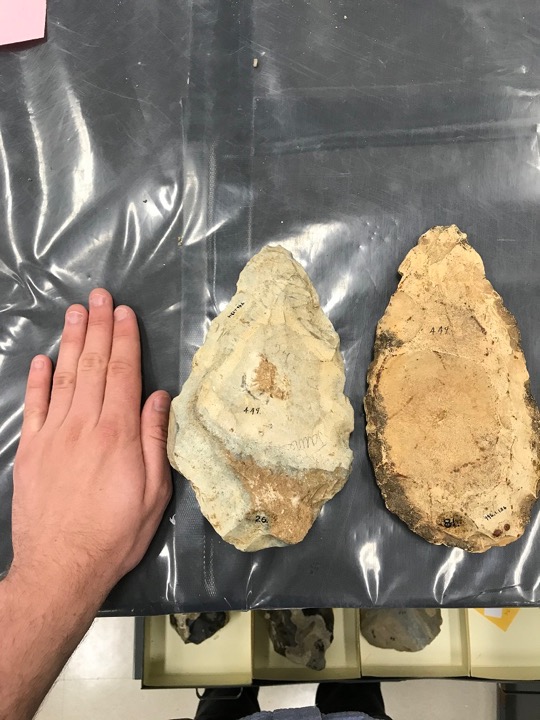2018 UAM Summer Internship: Careful, Sharp!
Martin Bierens - 8 June 2018

Acheulean Handaxes with hand for scale.
Since posting my last blog post I have had to opportunity to come work for two weeks in the Bryan/Gruhn Archaeology Collection. This is a teaching collection which has a large variety of archaeological material. For example, lithic material such as stone tools, pottery shards, and faunal remains. I have been helping to digitize some of the vast collection. This is the process of adding collections into digital databases so they are easily accessible. This allows researchers, museum staff, and the public to find certain items and browse collections. Digitization allows museums to make their collections accessible worldwide. At this point they have actually completed around 90% of the digitization project. I am helping to take photographs of some of the final items that are remaining. This involves taking pictures of items in a photo studio and then touching them up in Photoshop.
Photoshop, a popular computer program for editing photographs, has been the biggest learning curve for me these last few weeks. The difficult thing is that a camera lens does not see the world the same as a human eye. This means that for every image, I have to alter it to make sure that what you see on the screen looks like what you would find if you were looking for the artifact in the collection. What I have been able to do with Photoshop in just two weeks has astounded me! You are able to change anything and everything just by playing with the image. In the current digital climate, having a skill such as Photoshop will he very useful to me. Many museums worldwide are currently in the process of digitizing their collections. A working knowledge of Photoshop is a marketable skill for any future museum work I may be interested in!
Primarily I have been working with Shirley Harpham, the archaeological technologist for the Bryan/Gruhn Archaeology Collection, which contains the Ami Collection. This is a large collection that was donated to the University of Alberta by Dr. Henri-Marc Ami. Dr. Ami did an excavation in France in 1925, mainly the site at Combe-Capelle, where he was able to excavate a total of around 300,000 artifacts, 100,000 of which he saved, from the Lower Paleolithic to Neolithic periods. This is a time frame of around 3.3 million years ago up to about 4000 years ago. I am primarily working with specimens from the Upper Paleolithic, which is about 50,000 to 10,000 years ago. The Ami Collection was scattered to different Canadian universities with the University of Alberta being one of the recipients. The U of A has 1,876 specimens from Dr. Ami’s collection.
What I am mostly engaged with is a lot of lithic material, or stone tools, such as hand axes, scrapers, projectile points and hammer stones. It blew me away that after 50,000 years all of these flakes and tools as still sharp! You need to be careful, I have nearly cut myself a few times!
The highlight of these last two weeks for me has been being able to see more of the Bryan/Gruhn Archaeology Collection. As an anthropology student I have had some time in the collection through class work, but to actually be able to see it and look around with Shirley and on my own has been fascinating! Looking at artifacts from a woolly mammoth’s tooth, to Acheulean handaxes originating from some of the original dig sites around Saint-Acheul, France has been this anthropology student’s dream come true!